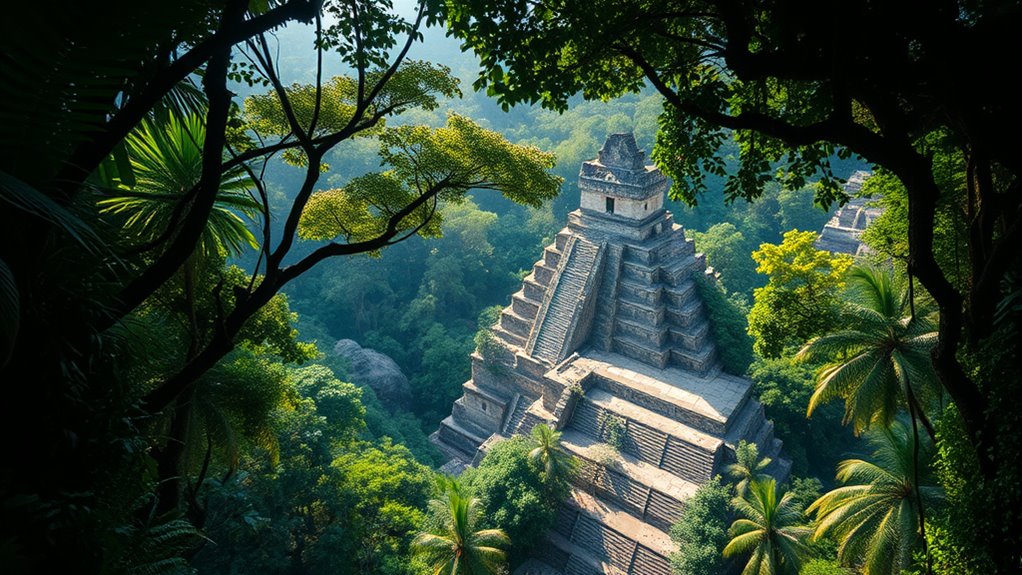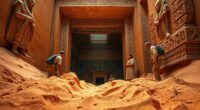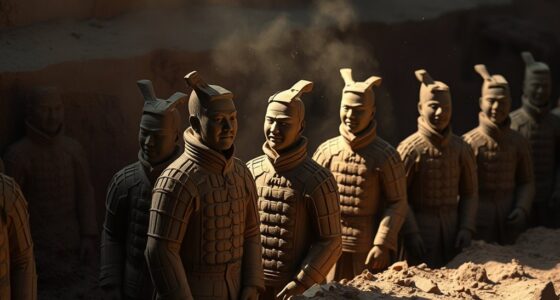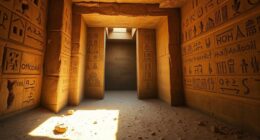Using laser scanning technology, scientists have uncovered a hidden Maya city deep within the jungle canopy. This advanced method creates detailed 3D models of the terrain and structures without disturbing the environment, revealing extensive urban layouts, architectural details, and features long concealed by vegetation. It highlights the Maya civilizations’ sophistication and sheds new light on their engineering skills. Continue exploring to discover more about how this breakthrough is revolutionizing archaeology and uncovering ancient secrets.
Key Takeaways
- Laser scanning revealed a previously unknown Maya city hidden beneath jungle foliage without physical excavation.
- High-resolution 3D models uncovered architectural features, city layout, and urban planning details.
- The non-invasive technology preserved fragile environments while providing comprehensive archaeological insights.
- Discoveries highlight the scale, sophistication, and astronomical alignment of the ancient Maya civilization.
- This breakthrough advances archaeological methods, enabling efficient, environmentally friendly exploration of lost sites.
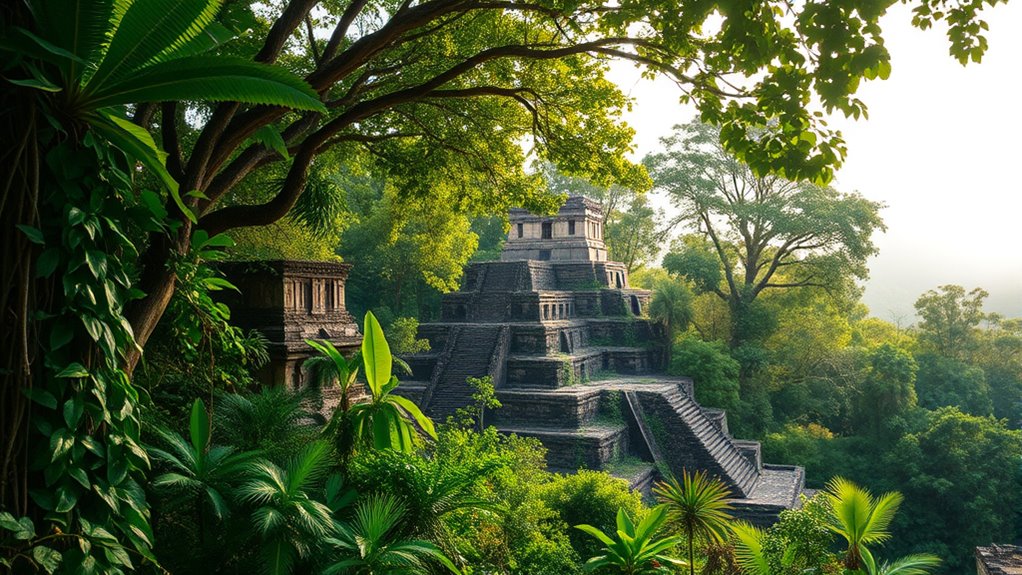
Thanks to advanced laser scanning technology, archaeologists have uncovered a previously unknown Maya city hidden deep within the jungle. This breakthrough allows you to explore a site that remained concealed for centuries, now brought into focus through the power of cutting-edge archaeological methods. The discovery reveals an extraordinary glimpse into the ancient architecture of the Maya civilization, showcasing impressive structures that defy previous expectations of their engineering and design capabilities. With laser scanning, archaeologists can create highly detailed 3D models of the terrain and structures without disturbing the fragile environment, making it an invaluable tool for uncovering hidden features beneath dense foliage.
Laser scanning uncovers hidden Maya structures, revealing detailed 3D models without disturbing the fragile jungle environment.
As you follow the process, you realize how laser scanning revolutionizes archaeological methods. Instead of traditional excavation, which can be invasive and time-consuming, this technology captures millions of data points from the air or ground, producing precise digital representations of the landscape. The advantage is that you can analyze the city’s layout and architectural details from afar, identifying building foundations, plazas, causeways, and terraces that might have been overlooked using conventional techniques. This method allows you to visualize the entire cityscape in three dimensions, revealing complex urban planning and sophisticated construction techniques that define the ancient architecture. It’s like holding history in your hands, but without disturbing the site.
The newfound city provides insights into the scale and sophistication of Maya urban centers. You see how the structures align with astronomical events, reflect social hierarchy, and serve religious purposes—all hallmarks of ancient architecture that tell stories of a thriving civilization. The ability to digitally reconstruct these buildings helps you understand their original appearance, including details like carved stone facades, roof combs, and intricate stuccoes. Such features, once hidden beneath layers of jungle growth, now come into view thanks to laser scanning, allowing you to appreciate the Maya’s craftsmanship and architectural ingenuity. Additionally, this technology demonstrates how multidisciplinary approaches enhance our understanding of archaeological sites by integrating science, technology, and history. Furthermore, the use of digital modeling allows for detailed analysis and preservation planning that was not possible before.
Furthermore, this discovery underscores how technology enhances archaeological methods. You realize that what once required extensive manual labor and guesswork can now be achieved through precise digital mapping. It enables you to uncover long-lost cities efficiently, conserving fragile sites while expanding our knowledge of ancient cultures. Modern laser scanning techniques can also be employed in other archaeological contexts, broadening the scope of what can be uncovered. As you absorb this breakthrough, it’s clear that laser scanning not only uncovers hidden cities but also deepens your understanding of ancient architecture and the ingenuity of civilizations long past. This fusion of technology and archaeology opens new doors for future discoveries, ensuring that the secrets of the Maya are no longer lost to history.
Frequently Asked Questions
How Old Is the Newly Discovered Maya City?
You’re curious about how old this newly discovered Maya city is. During jungle exploration, archaeologists found that the ancient architecture dates back over 1,000 years, making it a significant site from the Classic period of Maya civilization. This discovery sheds light on their advanced engineering and culture. The age of the city highlights its importance in understanding ancient history and the sophisticated society that once thrived in this lush jungle environment.
Were Any Artifacts Found at the Site?
You’ll be interested to learn that artifacts were indeed found at the site, which greatly enhances their artifact significance. These discoveries provide valuable insights into Maya culture and history. The excavation plans aim to carefully uncover and preserve these artifacts, ensuring they remain intact for study. As you follow the ongoing research, you’ll see how each artifact helps piece together the story of this ancient civilization.
What Challenges Were Faced During Laser Scanning?
As you navigate the dense jungle, you face environmental obstacles like thick foliage and unpredictable weather that hinder laser scanning. Technology limitations come into play too, with equipment struggling to penetrate dense canopy cover and uneven terrain. You must adapt your approach, overcoming these challenges to guarantee accurate data collection. Despite these hurdles, your persistence uncovers the secrets hidden beneath the jungle’s thick canopy, revealing the ancient city’s true extent.
How Does This Discovery Impact Our Understanding of Maya Civilization?
This discovery greatly deepens your understanding of the Maya civilization by revealing previously unknown ancient architecture, showing how advanced and expansive their society was. It highlights the cultural significance of their urban planning and construction skills, emphasizing their sophistication. You now see a richer picture of Maya life, their social complexity, and their ability to build enduring structures, which reshapes historical narratives and enhances appreciation for their remarkable achievements.
Will the Site Be Open to Public Visits Soon?
While you might be enthusiastic to visit the site soon, the focus remains on balancing tourism potential with preservation efforts. Authorities are evaluating how to open it responsibly, ensuring the ruins aren’t harmed. Although public access isn’t confirmed yet, the discovery’s significance encourages future tours. You’ll likely experience this extraordinary site once preservation measures are in place, allowing you to appreciate its history without risking its integrity.
Conclusion
As you marvel at this unexpected discovery, it’s almost like the jungle itself was hiding secrets just waiting to be revealed. The coincidence of advanced laser scanning uncovering a lost city shows how technology and nature unexpectedly intertwine. Maybe, in some strange way, the jungle’s dense embrace was protecting these ancient ruins all along, only to be uncovered when you least expected it. It’s a reminder that sometimes, discovery happens when you’re not looking for it.
